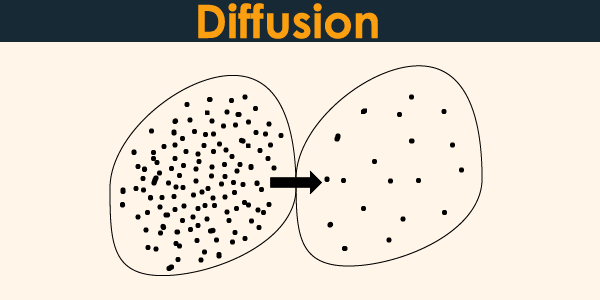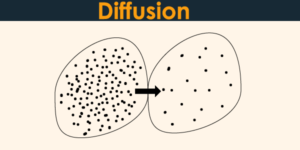
What Is Meant By Diffusion In Biology ?
Diffusion in biology is considered a passive form of cellular transport since it does not need additional energy for it to occur. It is the main form of transmission of essential substances (such as amino acids ) between cells. It is important for generating energy through respiration and photosynthesis.
Diffusion is a process at the molecular level and is determined by the random nature of the movement of individual molecules. It is the process of the net passive movement of particles from a higher concentration area to a lower concentration area in any mixture. It follows a downhill concentration gradient.

Types and Examples of diffusion in biology
There are two types of diffusion in biology.
- Simple diffusion: Some substances are not regulated by proteins in the cell membrane, which is called “simple diffusion”. It occurs in low molecular weight substances such as water (H 2 O), dissolved gases (O 2, CO 2 ), and fat-soluble molecules (ethyl alcohol, vitamin A).
It is the movement of molecules across a semi-permeable membrane without the help of protein channels. It is generated through permeable membranes from a medium with a higher concentration to a medium with a lower concentration until the concentration is equalized.
- Facilitated Diffusion: Such diffusion requires the assistance of proteins in the cell membrane. Its substances require transporters to cross selective permeability membranes. However, due to the different properties of the proteins in the cell membrane that assist the diffusion of substances.
In facilitated diffusion, transport is mediated by channels or carrier proteins. The facilitated transport involves the ions and the hydrophilic non-charged molecules which cannot cross the phospholipid double layer. The ions cross the membranes via proteins that form the ion channels.
Hydrophilic molecules, on the other hand, cross the membranes via the transport proteins.
I guess you want to learn more about it. Let’s dig into more depth.
Examples
- Mixing of gases or liquids.
- Nerve impulses, which involve sodium and potassium ions through the axon membrane.
- The entry of glucose into the red blood cells, coming from the intestine.
- The passage of oxygen in the pulmonary alveoli.
- If you put a tablespoon of sugar in a glass of water, the sucrose molecules diffuse through the water.
- In an estuary, less dense river water diffusion occurs than flows over seawater.
Example of diffusion in plants: For photosynthesis, the plant needs carbon dioxide. There are small holes underside of leaves which are known as stomata. Carbon dioxide diffuses into the leaves through these holes. Leaves produce oxygen and water vapor and these, in turn, diffuse out through the stomata.
Factors
- Short distance
- Large surface area
- Small molecular size
- Large concentration difference
- Temperature increase
Let’s compare it with another related head term
Diffusion and osmosis
Diffusion is the general term to define the movement of molecules from a high concentration region to a lower one, due to the effect of the kinetic energy of the molecules while osmosis is the process of a substance moving through a semi-permeable membrane to balance the concentration of another substance.